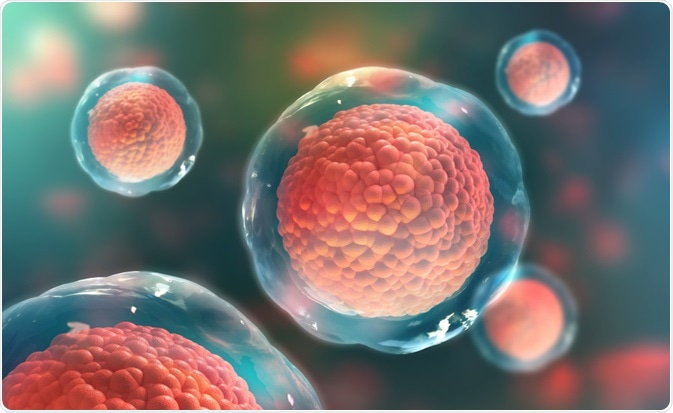Stem cells are a group of precursor cells that possess the ability to undergo cell division for self-renewal, and differentiation into different types of cells and tissue (potency) and usually come from a single cell (clonality). Similar to stem cells, progenitor cells are biological cells that can differentiate into a specific type of cell.

Stem Cells. Image Credit: Yurchanka Siarhei/Shutterstock.com
However, progenitor cells are more specific than stem cells and can differentiate to create specialized cell types. Stem cells can be used in cellular therapy to replace damaged cells or to regenerate organs. Stem cells can be used in regenerative medicine, promoting the repair response of dysfunctional or diseased tissues
Classification of stem cell-based on differentiation potential
There are various sources of stem cells with different potencies. According to their differentiation potential, stem cells can be classified into 5 groups: omnipotent or totipotent, pluripotent, multipotent, oligopotent, and unipotent.
What are stem cells? - Craig A. Kohn
Totipotent Stem Cells
The most undifferentiated cells are omnipotent or totipotent cells, which are found in early development. Totipotent cells such as fertilized oocyte and the cells of the first two divisions can differentiate into both embryonic and extra-embryonic tissues. Totipotency is not demonstrated in any vertebrate stem cells.
Pluripotent Stem Cells
Pluripotency describes the potential of stem cells to differentiate into three primary germ cell layers, but not extra-embryonic tissues such as the placenta. The three primary germ cell layers include endoderm (interior stomach lining, gastrointestinal tract, the lungs), mesoderm (muscle, blood, bone, urogenital), and ectoderm (epidermal tissues and nervous system) – from which all tissues and organs develop.
Sir John Gurdon and Shinya Yamanaka were awarded the Nobel Prize in Physiology or Medicine in 2012 for the breakthrough discovery that somatic cells can be reprogrammed to pluripotent stem cells, which are then called induced pluripotent stem cells. Embryonic stem cells and induced pluripotent stem cells are typical examples of pluripotency.
Multipotent Stem Cells
Multipotent stem cells are cells that can differentiate into multiple specialized cell types found in a specific tissue or organ. The most recognized multipotent cells are mesenchymal stem cells. They can be originated from different tissues such as adipose tissue, umbilical cord blood, bone marrow, bone, Wharton’s jelly, and peripheral blood.
Mesenchymal stem cells can adhere to cell culture dishes and are marked by distinct surface cell markers. These cells can differentiate into mesoderm-derived tissue including muscle, bone, cartilage, and adipose tissue.
Oligopotent Stem Cells
Oligopotent stem cells can transform into quite a limited number of several other types of cells. In other words, they can form two or more lineages within a specific tissue. One of the typical examples of oligopotent stem cells is hematopoietic stem cells, which can differentiate into both lymphoid and myeloid lineages.
Unipotent Stem Cells
Unipotent stem cells form a single lineage and differentiate into only one specific cell type. Spermatogonial stem cells and muscle stem cells are examples of unipotent stem cells. Adult stem cells are unipotent or oligopotent.
Use of Stem Cells in Regenerative Medicine
Human pluripotent stem cells, including embryonic or induced pluripotent stem cells, have great potential for cell therapy applications and disease modeling. Stem cells have been studied in most degenerative disorders.
For example, cellular reprogramming through induced pluripotent stem cells can be an alternative method for obtaining cardiomyocytes because of their ability to differentiate into cardiomyocytes. Therefore, pluripotent stem cells hold great potential for cardiac regeneration.
Findings of different studies showed promising results in many diseases such as heart failure diabetes mellitus, neurodegenerative diseases, chronic myeloid leukemia, cirrhosis, pulmonary fibrosis, Crohn’s disease, and nervous system disorders.
Embryonic stem cells are excellent tools that help in understanding human development and organogenesis. It is expected that induced pluripotent stem cells will pave the road to the discovery of new and safe therapies.
References
- Kolios G, Moodley Y. Introduction to stem cells and regenerative medicine. Respiration. 2013;85(1):3-10.
- Rossant J. Stem cells from the mammalian blastocyst. Stem cells. 2001 Nov;19(6):477-82.
- De Miguel MP, Fuentes-Julián S, Alcaina Y. Pluripotent stem cells: origin, maintenance, and induction. Stem Cell Reviews and Reports. 2010 Dec 1;6(4):633-49.
- Ratajczak MZ, Zuba-Surma E, Kucia M, Poniewierska A, Suszynska M, Ratajczak J. Pluripotent and multipotent stem cells in adult tissues. Advances in medical sciences. 2012 Jun 1;57(1):1-7.
- Ilic D, Polak JM. Stem cells in regenerative medicine: introduction. British medical bulletin. 2011 Jun 1;98(1):117-26.
- Ringe J, Kaps C, Burmester GR, Sittinger M. Stem cells for regenerative medicine: advances in the engineering of tissues and organs. Naturwissenschaften. 2002 Aug 1;89(8):338-51.
- Teo AK, Vallier L. Emerging use of stem cells in regenerative medicine. Biochemical Journal. 2010 May 15;428(1):11-23.
- Stocum DL. Stem cells in regenerative biology and medicine. Wound repair and regeneration. 2001 Nov;9(6):429-42.
- Smith A. A glossary for stem-cell biology. Nature. 2006 Jun;441(7097):1060-.
Further Reading
Last Updated: Feb 8, 2021